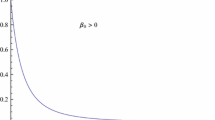Abstract
In this paper, we obtain exact solutions to the nonlinear system of partial differential equations (PDEs), describing the one dimensional unsteady simple flow of an isentropic, inviscid and perfectly conducting compressible fluid, subjected to a transverse magnetic field. Lie group of point transformations are used for constructing similarity variables which lead the governing system of PDEs to system of ordinary differential equations (ODEs); in some cases, it is possible to solve these equations exactly. A particular solution to the governing system, which exhibits space-time dependence, is used to study the evolutionary behavior of weak discontinuities.
Similar content being viewed by others
References
L. V. Ovsiannikkov, Group analysis of differential equations, Academic, New York (1982).
P. J. Olver, Application of Lie groups to differential equations, Springer, New York (1986).
G. W. Bluman and S. Kumei, Symmetries and differantial equations, Academic, New York (1989).
A. Donato and F. Oliveri, Reduction to autonomous form by group analysis and exact solutions of axisymmetric MHD equations, Math. Comput. Modelling, 18(10) (1993), 83–90.
F. Oliveri and M. P. Speciale, Exact solutions to the unsteady equations of perfect gases through Lie group analysis and substitution principles, Internat. J. Non-Linear Mech., 37(2) (2002), 257–274.
F. Oliveri and M. P. Speciale, Exact solutions to the ideal magnetogasdynamics equations through Lie group analysis and substitution principles, J. Phys. A, 38(40) (2005), 8803–8820.
D. Sahin, N. Antar and T. Ozer, Lie group analysis of gravity currents, Nonlinear Anal. Real World Appl., 11(2) (2010), 978–994.
T. Raja Sekhar and V. D. Sharma, Similarity solutions for three dimensional Euler equations using Lie group analysis, Appl. Math. Comput., 196(1) (2008), 147–157.
V. D. Sharma and R. Radha, Exact solutions of Euler equations of ideal gasdynamics via Lie group analysis, Z. Angew. Math. Phys., 59(6) (2008), 1029–1038.
M. Pandey, R. Radha and V. D. Sharma, Symmetry analysis and exact solutions of magnetogasdynamic equations, Quart. J. Mech. Appl. Math., 61(3) (2008), 291–310.
J. Jena, Lie group transformations for self-similar shocks in a gas with dust particles, Math. Methods Appl. Sci., 32(16) (2009), 2035–2049.
T. Rajasekhar and V. D. Sharma, Evolution of weak discontinuities in shallow water equations, Appl. Math. Lett., 23(3) (2010), 327–330.
W. F. Ames and A. Donato, On the evolution of weak discontinuities in a state characterized by invariant solutions, Internat. J. Non-Linear Mech., 23(2) (1988), 167–174.
L. P. Singh, A. Husain and M. Singh, A self-similar solution of exponential shock waves in non-ideal magnetogasdynamics, Meccanica 46 (2) (2011), 437–445.
V. D. Sharma, Quasilinear hyperbolic systems, compressible flows, and waves, CRC Press, Boca Raton, FL, (2010).
T. Raja Sekhar and V. D. Sharma, Solution to the Riemann problem in a one-dimensional magnetogasdynamic flow, Int. J. Comput. Math., 89(2) (2012), 200–216.
T. Raja Sekhar and V. D. Sharma, Riemann problem and elementary wave interactions in isentropic magnetogasdynamics, Nonlinear Anal. Real World Appl., 11(2) (2010), 619–636.
J. F. Clarke, Small amplitude gasdynamic disturbances in an exploding atmosphere, J. Fluid Mech., 89(2) (1978), 343–355.
G. J. Pert, Self-similar flow with uniform velocity gradient and their use in modelling the free expansion of polytropic gases, J. Fluid Mech., 100(2) (1980), 257–277.
V. D. Sharma, R. Ram and P. L. Sachdev, Uniformly valid analytical solution to the problem of a decaying shock wave, J. Fluid Mech., 185 (1987), 153–170.
G. Boillat and T. Ruggeri, On evolution law of weak discotinuities for hyberbolic quasilinear systems, Wave Motion 1(2) (1979), 149–152.
Author information
Authors and Affiliations
Corresponding author
Rights and permissions
About this article
Cite this article
Bira, B., Sekhar, T.R. Symmetry group analysis and exact solutions of isentropic magnetogasdynamics. Indian J Pure Appl Math 44, 153–165 (2013). https://doi.org/10.1007/s13226-013-0008-9
Received:
Accepted:
Published:
Issue Date:
DOI: https://doi.org/10.1007/s13226-013-0008-9



